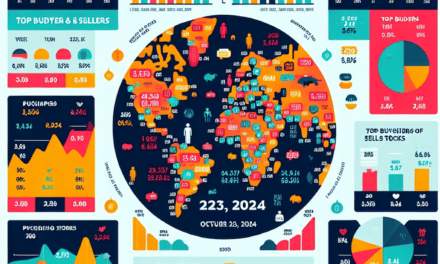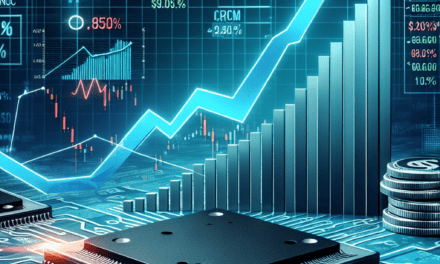“Timeless Investment: The One Stock for a Lifetime of Growth”
Introduction
Investing in the stock market often involves navigating a complex landscape of risks and opportunities, but for those seeking a long-term strategy, identifying a single stock to buy and hold forever can be a compelling approach. The ideal candidate for such an investment is a company with a robust business model, a strong competitive advantage, and a proven track record of growth and resilience. This stock should not only demonstrate consistent financial performance but also possess the adaptability to thrive amid changing market conditions and technological advancements. By focusing on a company that embodies these qualities, investors can potentially secure a cornerstone asset in their portfolio, offering both stability and the promise of enduring value over time.
Understanding the Fundamentals: Why This Stock Stands Out
In the ever-evolving landscape of the stock market, identifying a single stock to buy and hold forever is a daunting task. However, when considering the fundamentals that make a stock stand out, one must look beyond short-term fluctuations and focus on long-term potential. Among the myriad of options available, one stock that consistently emerges as a compelling choice is Apple Inc. This technology giant, with its robust business model, innovative prowess, and strong financial health, exemplifies the qualities that make it a standout investment for the long haul.
To begin with, Apple’s business model is a cornerstone of its enduring success. The company has built an ecosystem that seamlessly integrates hardware, software, and services, creating a loyal customer base that is deeply embedded in its products. This ecosystem not only drives repeat purchases but also fosters brand loyalty, making it difficult for competitors to lure customers away. Furthermore, Apple’s ability to innovate and set trends in the technology sector is unparalleled. From the introduction of the iPhone to the development of the Apple Watch and AirPods, the company has consistently demonstrated its capacity to revolutionize consumer technology. This commitment to innovation ensures that Apple remains at the forefront of the industry, continually attracting new customers and retaining existing ones.
In addition to its innovative capabilities, Apple’s financial health is a testament to its strength as a long-term investment. The company boasts a formidable balance sheet, characterized by substantial cash reserves and minimal debt. This financial stability not only provides a buffer against economic downturns but also enables Apple to invest in research and development, further fueling its innovation engine. Moreover, Apple’s consistent revenue growth and profitability underscore its ability to generate shareholder value over time. The company’s strong financial performance is reflected in its ability to return capital to shareholders through dividends and share buybacks, making it an attractive option for investors seeking both growth and income.
Transitioning to the broader market context, Apple’s global reach and adaptability are additional factors that contribute to its appeal as a forever stock. The company has successfully navigated various market challenges, including geopolitical tensions and supply chain disruptions, by leveraging its extensive network of suppliers and partners. This resilience is indicative of Apple’s strategic foresight and operational excellence, which are crucial for sustaining long-term growth. Furthermore, Apple’s expansion into emerging markets presents significant opportunities for future growth. As disposable incomes rise and technology adoption accelerates in these regions, Apple is well-positioned to capture a larger share of the market, thereby enhancing its growth prospects.
In conclusion, while the stock market is inherently unpredictable, Apple’s strong fundamentals make it a standout choice for those seeking a stock to buy and hold forever. The company’s innovative spirit, robust financial health, and strategic adaptability position it as a leader in the technology sector, capable of weathering market fluctuations and capitalizing on new opportunities. By focusing on these core attributes, investors can gain confidence in Apple’s ability to deliver sustained value over the long term. Thus, for those looking to make a lasting investment, Apple Inc. emerges as a compelling option that embodies the principles of sound investing.
Long-Term Growth Potential: Analyzing Market Trends
When considering a stock to buy and hold forever, it is crucial to analyze long-term growth potential by examining prevailing market trends. In today’s rapidly evolving economic landscape, identifying a company that not only adapts to change but also thrives amidst it is essential for sustained investment success. One such company that stands out in this regard is Apple Inc., a technology giant that has consistently demonstrated resilience and innovation.
To begin with, Apple’s ability to maintain a competitive edge in the technology sector is a testament to its robust business model and strategic foresight. The company’s commitment to research and development has resulted in a continuous stream of innovative products and services, ranging from the iconic iPhone to the burgeoning services segment, which includes Apple Music, iCloud, and the App Store. This diversification not only mitigates risk but also positions Apple to capitalize on emerging trends in consumer technology.
Moreover, Apple’s strong brand loyalty and expansive ecosystem create a formidable moat that protects its market share. The seamless integration of hardware, software, and services fosters a user experience that is difficult for competitors to replicate. This ecosystem not only encourages repeat purchases but also attracts new customers, thereby driving sustained revenue growth. As a result, Apple has consistently delivered impressive financial performance, with a track record of robust revenue and profit margins.
In addition to its product innovation and brand strength, Apple’s strategic focus on sustainability and environmental responsibility aligns with the growing trend of socially conscious investing. The company has made significant strides in reducing its carbon footprint, committing to using 100% recycled materials in its products and achieving carbon neutrality across its supply chain. This commitment not only enhances Apple’s reputation but also appeals to a growing segment of investors who prioritize environmental, social, and governance (ESG) factors.
Furthermore, Apple’s financial health is another compelling reason to consider it as a long-term investment. The company boasts a strong balance sheet, characterized by substantial cash reserves and minimal debt. This financial stability provides Apple with the flexibility to invest in new growth opportunities, weather economic downturns, and return capital to shareholders through dividends and share buybacks. Such financial prudence ensures that Apple remains well-positioned to navigate the uncertainties of the global economy.
Transitioning to the broader market context, the technology sector as a whole is poised for continued growth, driven by advancements in artificial intelligence, 5G connectivity, and the Internet of Things (IoT). Apple’s strategic investments in these areas, coupled with its established market presence, position it to benefit from these transformative trends. As digital transformation accelerates across industries, Apple’s products and services are likely to see increased demand, further bolstering its growth prospects.
In conclusion, when evaluating a stock to buy and hold forever, Apple’s long-term growth potential, underpinned by its innovation, brand strength, commitment to sustainability, and financial health, makes it a compelling choice. By aligning itself with key market trends and maintaining a focus on delivering value to customers and shareholders alike, Apple is well-equipped to continue its trajectory of success. As such, it represents a prudent investment for those seeking to capitalize on the enduring growth opportunities within the technology sector.
The Company’s Competitive Edge: What Sets It Apart
In the ever-evolving landscape of global markets, identifying a stock that promises enduring value is a formidable challenge. However, when considering a company to buy and hold forever, one must look beyond short-term gains and focus on sustainable competitive advantages. A company that exemplifies this is Apple Inc., a titan in the technology sector. Apple’s competitive edge is rooted in its unique blend of innovation, brand loyalty, and ecosystem integration, which collectively set it apart from its competitors.
To begin with, Apple’s commitment to innovation is unparalleled. The company has consistently demonstrated an ability to not only anticipate consumer needs but also to create demand for products that redefine entire industries. The introduction of the iPhone in 2007 is a prime example of this, as it revolutionized the smartphone market and set a new standard for mobile technology. This culture of innovation is deeply ingrained in Apple’s DNA, ensuring that it remains at the forefront of technological advancements. Moreover, Apple’s substantial investment in research and development underscores its dedication to maintaining this innovative edge, allowing it to continuously introduce cutting-edge products and services.
In addition to its innovative prowess, Apple’s brand loyalty is a formidable asset that distinguishes it from its peers. The company has cultivated a loyal customer base that is not only willing to pay a premium for its products but also remains steadfastly committed to the brand. This loyalty is a testament to the quality and reliability of Apple’s offerings, as well as the emotional connection that consumers have with the brand. The iconic Apple logo is synonymous with excellence and prestige, further reinforcing customer allegiance. This strong brand loyalty translates into consistent revenue streams and provides a buffer against market volatility, making Apple a resilient choice for long-term investment.
Furthermore, Apple’s ecosystem integration is a critical component of its competitive advantage. The seamless interoperability of its products and services creates a cohesive user experience that is difficult for competitors to replicate. From the iPhone and iPad to the Mac and Apple Watch, each device is designed to work harmoniously with the others, fostering a sense of continuity and convenience for users. This integration extends to Apple’s software and services, such as iCloud, Apple Music, and the App Store, which enhance the overall user experience and encourage customers to remain within the Apple ecosystem. As a result, the company’s ecosystem not only drives customer retention but also opens up additional revenue streams through services and accessories.
Moreover, Apple’s strategic focus on sustainability and corporate responsibility further solidifies its competitive edge. The company has made significant strides in reducing its environmental impact, with initiatives aimed at achieving carbon neutrality and utilizing recycled materials in its products. This commitment to sustainability resonates with consumers who are increasingly prioritizing environmental considerations in their purchasing decisions. By aligning its business practices with these values, Apple not only enhances its brand image but also positions itself as a leader in corporate responsibility.
In conclusion, Apple’s competitive edge is a multifaceted construct that encompasses innovation, brand loyalty, ecosystem integration, and sustainability. These elements collectively set Apple apart from its competitors and provide a solid foundation for long-term growth and stability. For investors seeking a stock to buy and hold forever, Apple’s enduring competitive advantages make it a compelling choice, promising not only financial returns but also alignment with broader societal values.
Financial Health: A Deep Dive into the Balance Sheet

When considering a stock to buy and hold forever, a thorough examination of the company’s financial health is paramount. The balance sheet, a fundamental financial statement, provides a snapshot of a company’s financial position at a specific point in time. It is composed of three main components: assets, liabilities, and shareholders’ equity. Each of these elements offers critical insights into the company’s operational efficiency, financial stability, and long-term viability.
To begin with, assets are resources owned by the company that are expected to generate future economic benefits. They are typically divided into current and non-current assets. Current assets, such as cash, accounts receivable, and inventory, are expected to be converted into cash within a year. Non-current assets, including property, plant, equipment, and intangible assets like patents, are long-term investments. A company with a robust asset base is often better positioned to weather economic downturns and capitalize on growth opportunities. Therefore, when selecting a stock to hold indefinitely, it is crucial to assess the quality and liquidity of its assets.
Transitioning to liabilities, these represent the company’s financial obligations. Similar to assets, liabilities are categorized as current or long-term. Current liabilities, such as accounts payable and short-term debt, are due within a year, while long-term liabilities, like bonds payable and long-term loans, extend beyond a year. A company with manageable liabilities relative to its assets is generally considered financially healthy. The debt-to-equity ratio, a key metric derived from the balance sheet, provides insight into the company’s leverage and risk profile. A lower ratio suggests a more conservative capital structure, which can be advantageous in volatile markets.
Furthermore, shareholders’ equity, also known as net assets or book value, represents the residual interest in the company’s assets after deducting liabilities. It is essentially the net worth of the company from the shareholders’ perspective. A consistently growing shareholders’ equity indicates that the company is effectively reinvesting its earnings to generate additional value for its shareholders. This growth is often reflected in the company’s stock price appreciation over time, making it an attractive choice for long-term investors.
In addition to these components, the balance sheet also reveals important information about the company’s liquidity and solvency. Liquidity ratios, such as the current ratio and quick ratio, measure the company’s ability to meet its short-term obligations. A higher ratio indicates a stronger liquidity position, which is crucial for maintaining operations during economic fluctuations. Solvency ratios, on the other hand, assess the company’s capacity to meet its long-term obligations. A solid solvency position suggests that the company can sustain its operations and growth over the long term.
In conclusion, a comprehensive analysis of the balance sheet is essential when selecting a stock to buy and hold forever. By examining the company’s assets, liabilities, and shareholders’ equity, investors can gain valuable insights into its financial health and long-term prospects. A company with a strong asset base, manageable liabilities, and growing shareholders’ equity is likely to provide sustainable returns over time. Therefore, the balance sheet serves as a critical tool for identifying a stock that aligns with the investor’s long-term financial goals.
Leadership and Vision: The Role of Management in Success
In the ever-evolving landscape of the stock market, selecting a single stock to buy and hold forever is a daunting task. However, when considering such a long-term investment, the role of management in steering a company towards sustained success cannot be overstated. Leadership and vision are pivotal in determining a company’s trajectory, and thus, they become crucial factors in the decision-making process for investors seeking enduring value.
A company’s management team is the cornerstone of its strategic direction and operational efficiency. Effective leaders possess the foresight to navigate through market fluctuations, technological advancements, and competitive pressures. They are adept at crafting a vision that not only aligns with current market demands but also anticipates future trends. This visionary approach is essential for fostering innovation and ensuring that the company remains relevant in an ever-changing business environment.
Moreover, strong leadership is characterized by the ability to execute strategies effectively. This involves making informed decisions that balance short-term gains with long-term objectives. A management team that demonstrates a commitment to sustainable growth is more likely to cultivate a resilient business model. This resilience is crucial for weathering economic downturns and capitalizing on opportunities during periods of expansion. Consequently, investors should prioritize companies with leadership that has a proven track record of strategic execution and adaptability.
In addition to strategic acumen, the ethical standards upheld by a company’s management are equally important. Leaders who prioritize corporate governance and transparency foster trust among stakeholders, including investors, employees, and customers. This trust is a valuable asset, as it enhances the company’s reputation and can lead to increased customer loyalty and employee satisfaction. Furthermore, ethical leadership is often indicative of a company that is mindful of its social and environmental responsibilities, which is increasingly important in today’s socially conscious market.
Another critical aspect of effective management is the ability to cultivate a strong corporate culture. A positive and inclusive work environment can drive employee engagement and productivity, which in turn contributes to the company’s overall success. Leaders who invest in their workforce by promoting diversity, offering professional development opportunities, and recognizing employee contributions are likely to build a motivated and innovative team. This internal strength can be a significant competitive advantage, enabling the company to attract and retain top talent.
When considering a stock to buy and hold forever, it is also essential to evaluate the company’s financial health and market position. However, these factors are often a reflection of the leadership’s effectiveness. A company with a robust balance sheet and a dominant market presence is likely benefiting from sound management practices. Therefore, investors should look for companies where leadership has demonstrated the ability to drive financial performance while maintaining a strategic focus on long-term growth.
In conclusion, the role of management in a company’s success cannot be underestimated when selecting a stock for a lifetime investment. Leadership and vision are integral to navigating the complexities of the business world and ensuring sustained value creation. By prioritizing companies with strong, ethical, and visionary management teams, investors can increase their chances of selecting a stock that will stand the test of time. Ultimately, it is the leadership’s ability to adapt, innovate, and inspire that will determine a company’s enduring success in the marketplace.
Dividend History: Consistent Returns for Shareholders
When considering a stock to buy and hold forever, one of the most compelling factors to examine is its dividend history. A company with a consistent track record of paying dividends not only demonstrates financial stability but also a commitment to returning value to its shareholders. This reliability can be particularly appealing to long-term investors seeking steady income streams and potential capital appreciation. In this context, the dividend history of a company serves as a crucial indicator of its overall health and future prospects.
A company with a robust dividend history often reflects a well-established business model and a strong market position. These companies typically generate substantial cash flows, allowing them to distribute a portion of their earnings to shareholders regularly. This consistent return can be especially attractive in volatile markets, where stock prices may fluctuate significantly. Dividends provide a cushion against market downturns, offering investors a tangible return on their investment even when capital gains are elusive.
Moreover, companies with a history of increasing dividends over time signal their confidence in future earnings growth. This practice, known as dividend growth, is a powerful indicator of a company’s long-term viability. It suggests that the company not only has the capacity to maintain its current dividend payouts but also anticipates continued financial success. For investors, this can translate into a growing income stream, which is particularly beneficial for those relying on dividends as a source of income during retirement.
In addition to providing income, dividends can also play a significant role in compounding returns over time. Reinvesting dividends to purchase additional shares can lead to exponential growth in an investor’s portfolio. This strategy, known as dividend reinvestment, allows investors to take advantage of the power of compounding, as each dividend payment buys more shares, which in turn generate more dividends. Over the long term, this can significantly enhance the total return on investment, making dividend-paying stocks an attractive option for those with a buy-and-hold strategy.
Furthermore, a strong dividend history can serve as a buffer against inflation. As the cost of living rises, the purchasing power of fixed income streams diminishes. However, companies that consistently increase their dividends can help investors maintain their purchasing power by providing a growing income stream that keeps pace with or exceeds inflation. This aspect is particularly important in today’s economic environment, where inflationary pressures are a concern for many investors.
While past performance is not a guarantee of future results, a company with a solid dividend history is often better positioned to weather economic challenges. These companies tend to have strong balance sheets, prudent management, and a focus on sustainable growth. As a result, they are more likely to navigate economic downturns successfully and continue providing returns to shareholders.
In conclusion, when selecting a stock to buy and hold forever, a consistent dividend history is a key factor to consider. It not only reflects a company’s financial health and commitment to shareholders but also offers the potential for steady income, capital appreciation, and protection against inflation. For long-term investors, these attributes make dividend-paying stocks an appealing choice, providing both stability and growth potential in an ever-changing market landscape.
Risk Factors: What to Watch Out for in the Future
When considering a stock to buy and hold forever, it is crucial to evaluate the potential risk factors that could impact its long-term performance. While the allure of a promising stock can be compelling, investors must remain vigilant about the various challenges that could arise over time. One of the primary risk factors to consider is market volatility. Stock markets are inherently unpredictable, and even the most stable companies can experience fluctuations in their stock prices due to broader economic conditions. Therefore, it is essential to assess how resilient a company is to market swings and whether it has a robust strategy to navigate economic downturns.
In addition to market volatility, regulatory changes pose another significant risk. Companies operating in heavily regulated industries, such as finance or healthcare, must constantly adapt to new laws and regulations. These changes can affect profitability and operational efficiency, potentially impacting the stock’s long-term value. Investors should keep an eye on the regulatory landscape and consider how potential changes could influence the company’s business model.
Technological advancements also present both opportunities and risks. While innovation can drive growth and open new markets, it can also render existing products or services obsolete. Companies that fail to adapt to technological changes risk losing their competitive edge. Therefore, it is crucial to evaluate whether a company is investing in research and development and whether it has a track record of successfully integrating new technologies into its operations.
Furthermore, geopolitical risks can have far-reaching implications for a company’s performance. Political instability, trade tensions, and international conflicts can disrupt supply chains, affect consumer demand, and lead to increased costs. Companies with a global presence are particularly vulnerable to these risks, and investors should consider how geopolitical events might impact the company’s operations and financial health.
Another critical factor to consider is the company’s financial health. A strong balance sheet, healthy cash flow, and manageable debt levels are indicators of a company’s ability to weather economic storms. Investors should scrutinize financial statements to ensure that the company is not over-leveraged and that it has sufficient liquidity to meet its obligations. Additionally, a history of consistent earnings growth and prudent financial management can provide reassurance that the company is well-positioned for long-term success.
Moreover, environmental, social, and governance (ESG) factors are increasingly important in assessing a company’s sustainability and ethical practices. Companies that prioritize ESG considerations are often better equipped to manage risks related to environmental regulations, social responsibility, and corporate governance. As investors become more conscious of these issues, companies with strong ESG credentials may enjoy a competitive advantage and attract more investment.
Lastly, it is essential to consider the company’s leadership and corporate culture. Effective leadership can drive innovation, inspire employee engagement, and foster a positive corporate culture. A company with visionary leaders and a strong ethical foundation is more likely to navigate challenges successfully and capitalize on opportunities.
In conclusion, while the prospect of buying and holding a stock forever is appealing, it requires careful consideration of various risk factors. By evaluating market volatility, regulatory changes, technological advancements, geopolitical risks, financial health, ESG factors, and leadership quality, investors can make informed decisions and select a stock that is well-equipped to thrive in the face of future uncertainties.
Q&A
1. **Question:** What is the primary characteristic of a stock that one would choose to buy and hold forever?
– **Answer:** The primary characteristic is a strong, sustainable competitive advantage or “moat” that ensures long-term growth and profitability.
2. **Question:** Why is it important for the chosen stock to have a history of consistent dividend payments?
– **Answer:** Consistent dividend payments indicate financial stability and a commitment to returning value to shareholders, which is crucial for long-term investment.
3. **Question:** How does market leadership influence the decision to buy and hold a stock forever?
– **Answer:** Market leadership suggests dominance in the industry, which often translates to better pricing power, customer loyalty, and resilience against competitors.
4. **Question:** What role does innovation play in selecting a stock to hold indefinitely?
– **Answer:** Innovation is key to adapting to market changes and sustaining growth, ensuring the company remains relevant and competitive over time.
5. **Question:** Why is a strong management team important for a stock that one plans to hold forever?
– **Answer:** A strong management team is crucial for strategic decision-making, effective resource allocation, and navigating challenges, which supports long-term success.
6. **Question:** How does global diversification impact the choice of a stock to buy and hold forever?
– **Answer:** Global diversification reduces reliance on a single market, spreads risk, and taps into growth opportunities across different regions, enhancing stability.
7. **Question:** What financial metrics are important when evaluating a stock to hold forever?
– **Answer:** Important financial metrics include revenue growth, profit margins, return on equity, and free cash flow, as they indicate financial health and growth potential.
Conclusion
Investing in a single stock to buy and hold forever requires careful consideration of a company’s long-term growth potential, financial stability, and market position. A strong candidate would be a company with a proven track record of innovation, consistent revenue growth, and a robust competitive advantage. Additionally, it should operate in an industry with enduring demand and have a solid management team committed to shareholder value. While no investment is without risk, selecting a stock that embodies these qualities increases the likelihood of sustained returns over time. Ultimately, the choice should align with the investor’s risk tolerance and financial goals, ensuring a well-considered decision for long-term wealth accumulation.





